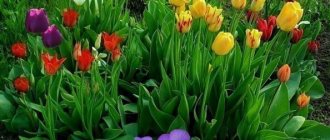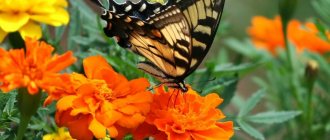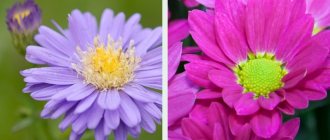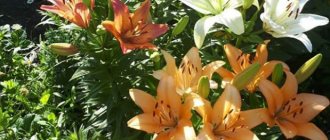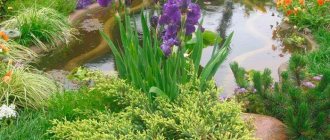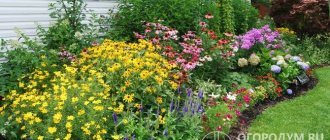Bulbous flowers for the garden get their name due to the thick stem, which has the shape of a tuber. These flowers are unpretentious, since the bulb itself contains all the microelements necessary for proper development.
Bulbous plants wake up after winter as the very first among perennials and arrange a real spring festival in the garden.
There are a huge number of varieties of bulbous plants. Flowering occurs from early spring to autumn.
Planting in a flowerbed
This is the easiest way to “install” bulbous crops in the garden, which need to be dug up annually. First of all, these are hyacinths and tulips (representatives of the groups Fringed, Liliaceae, Parrotaceae, Green-flowered, Early Terry and Late Terry). Usually in such plantings they are combined with early flowering biennials : daisies , forget-me-nots, pansies, horned violet.
Planting in a flower bed is the easiest way to add bulbs to the garden, which need to be dug up annually.
Important : after the bulbs have faded and their leaves have dried, the plants are dug up for storage, and flowering annuals .
What to plant with lilies
Plant lilies in small groups of the same variety. This option looks best against the backdrop of hedges, tall bushes, fences and walls. Excellent companions in this case will be roses, azalea, barberry, fern, and various conifers.
Combinations with bergenia or herbaceous peony and hostas will be harmonious.
In mixborder
Bulbous plants will help to “color” empty spaces in the spring in a mixborder with shrubs and perennials. For this purpose, it is convenient to use small-bulbous plants , tender anemone, daffodils, tulips from the groups Triumph, Darwin hybrids, Kaufman, Greig, Foster, as well as species (they can grow in one place for several years without digging).
In a mixborder with shrubs and perennials, bulbous plants will help color empty spaces in spring
When the bulbous leaves begin to fade, the growing foliage of the perennials will cover them.
LiveInternetLiveInternet
Bulbs are the first to greet the beginning of spring. They bloom already in April, when perennials are just awakening from winter hibernation. Therefore, in every flower garden there is at least a couple of bulbous primroses, enlivening the dull landscape of flower beds and giving a spring mood. Some helpful tips for seeding and flowerbed designs.
First of all, for bulbous plants, you should choose a planting location so that you can admire your flowers. After all, it is the bulbous ones that will decorate the garden during the spring months - after the cold weather they are especially dear to us. In early spring, the craving for beauty is most acutely felt, when during the long gloomy winter we have yearned for bright colors and spectacular forms.
In a small home garden, where, as a rule, there is little free space, early spring bulbous plants can be placed in close proximity to perennials. When the early spring bulbs fade, the unsightly fading tops will be covered by the foliage of growing perennials, such as peonies, ferns or hostas.
Low-growing crocuses, snowdrops, and pushkinias bloom first. Their flowers are located almost on the surface of the earth. In order to be able to see the charming crumbs up close, they should be planted on the edge of flower beds, near paths and paths. Daffodils and tulips, which have large flowers and later flowering periods, can be placed in the background and middle ground of flower beds and in remote corners of the garden. Plant hyacinths and muscari, which give a surprisingly delicate aroma, near the bench and under the windows.
For greater decorativeness, small bulbous plants are planted in groups of 8-10 or more pieces. White snowdrops, pushkinias, purple, lilac, yellow crocuses planted in small groups look very impressive. If you choose a place for planting where the snow melts first, the primroses will bloom early. In order for the plants to bloom at the same time in the spring and have the same height, it is necessary to form a group of bulbs of approximately the same size. Then the flower island will look most neat and impressive.
You don’t have to dig up tulips for two to three years, and daffodils for up to five years. Small-bulbous plants, once planted, can no longer be disturbed at all. Over time, growing in width, they form bright picturesque spots. But in this case, do not forget to somehow (with a flag, a label) mark the places where the bulbs are planted even before the above-ground part of the plants dies. Otherwise, in the fall, when digging the soil, you can damage the dormant bulbs.
When planting bulbs on a lawn or under trees, they are placed so that groups of flowers look natural and appear to be growing wild. In practice, the planting technology is as follows: pour out the bulbs from the palm of your hand near the tree, where the bulb fell - and plant it there. This way you will achieve maximum naturalness of the fit.
Remember to water your flowers regularly during and after flowering, so the flowers will retain their green foliage much longer. Tip: you need to water the plants so that the moisture penetrates into the area where the bulk of the roots occur. On average, each watering consumes from 10 to 40 liters. Water per 1 square meter. To avoid leaf burns, avoid getting water on the leaves when watering on a sunny day.
Feeding with a universal complex fertilizer when sprouts appear and during budding is a zoologist for a beautifully blooming garden.
The only thing bulbs need in the spring is watering. And then only if the spring is dry. As soon as the plants begin to bloom, it is necessary, as with any flower crop, to remove the faded inflorescences. This way the flower garden will have a well-groomed appearance, and the plants will not lose strength to form seeds. Remember: no matter how much you want, yellowed leaves cannot be removed; they must die off on their own, without intervention. This way the plant will be able to fully restore the bulb, which means it will delight you with lush flowering next season.
Flowerbed projects.
List of plants. 1. Aflatun onion (Allium aflatunense), 20 pcs. 2. Tulip "Golden Apeldoorn" (Tulipa 'Golden Apeldoorn'), 24 pcs. 3. Hybrid jaundice “Rysi Moon” (Erysimum hybrid 'Rysi Moon'), 15 pcs. 4. Stemless primrose "Euro Blue" (Primula acaulis 'Euro Blue'), 40 pcs.
1. Hyacinth 2. Imperial hazel grouse Z. Tulip 4. Narcissus 5. Rhododendron
1. Tender anemone 2. Tulip Z. Hyacinth
Based on materials: https://www.7ya.ru/article/Zakladyvaem-rannevesennyuyu-klumbu/, https://altaiflora.hostenko.com/shema-glubinyi-posadki-lukovichnyih/, https://superdom.ua/view /3832-proekt-majskoj-klumby-s-lukovichnymi-cvetami.html
Patterns on the grass
from varietal daffodils on the lawn.
You can make intricate designs from varietal daffodils on the lawn
Important : do not mow their planting sites until the leaves have completely dried out (approximately until the end of June). You can start mowing the remaining corners of the green carpet with a clear conscience in May. This “patterned” mowing looks quite nice.
4. In the rock garden
Here the conditions are created in which many bulbous plants live in nature: rocky soil, good drainage, plenty of sun.
Colchicums in rockeries
will take root well in rockeries (Batalin's tulip, T. Foster's, T. pretty, T. rocky, T. Sprenger's, T. late), low onions, Chionodoxa Forbes, colchicums , crocuses , wintering spring flowers, kandyki , hazel grouse , iridodictiums , white flowers , dwarf daffodils, muscari .
Crocus
With the arrival of warmer weather, crocuses are the first to sprout, opening the gardening season.
The earliest varieties can be seen in our area already at the end of March. The timing of planting bulbs in the fall depends on the climatic conditions of a particular region, but usually it is from early September to mid-October. Crocuses are unpretentious, they need dry soil with good drainage and sunlight. The area where the flowers will grow should be open, but protected from wind and snow drifts. The best option is an alpine slide. If you plant the bulbs deeper, the crocuses will bloom and grow longer, and you will have to separate them and plant the “babies” less often. But you shouldn’t go below 10 cm. Most crocuses are not afraid of the cold, but after the first frost, it is advisable to loosen the soil in the area and mulch it with peat or fallen leaves.
Spring varieties should be distinguished from autumn varieties, which appear in our gardens at the end of August. The flowering dates for crocuses (and other ornamental plants) are indicated on the packaging.
In semi-shade flower beds
Some bulbous plants can also be used in semi-shade flower beds. In such conditions, snowdrops, white flowers, goose onions, kandyks, daffodils, onions (strange, bear and victory), blueberries, checkered hazel grouse and chionodoxes and even some tulips (Delacluse and pretty varieties) will feel good.
Left: Muscari on the lawn. Right: Daffodils can also be used in semi-shade flower beds
On the beds
In addition to the fact that some bulbous plants are garden crops ( onions , shallots , skoroda , garlic ), beds with seedlings can be decorated with tulips and hyacinths. Then in the spring, when vegetables or green crops have not yet grown, the garden will not look so empty.
Beds with seedlings can be decorated with tulips and hyacinths
What to plant with peonies
Peony companions should compromise on the size of the inflorescences. We will build on this rule when choosing neighbors for these colors. Color combinations are also important.
- A decorative bow will look good with burgundy.
- With pink ones - combine thuja and barberry.
- The beauty of light and coral colors is best emphasized by iris, carnation, heuchera, and daylily.
Season is another important criterion. Let the flowerbed be filled with crocuses, daffodils and tulips in early spring. In summer - lilies and astilbes. In autumn - asters and dahlias.
Bulbs in pots
An excellent option for “mobile” flower beds on paved areas and wooden decks. In the fall, the bulbs are planted in deep plastic containers and buried in the garden for the winter. In the spring, the containers are dug out and inserted into decorative flowerpots of suitable size. After flowering, the plastic pots are transferred to the utility part of the garden, and when the foliage finally dries, the bulbs are dug up for summer storage.
Important : in deep, wide containers you can plant several types of bulbs at once - deeper - those that bloom later, and closer to the surface - those that bloom earlier.
Left: bulbs in pots. Right: Every year, breeders develop amazing varieties of bulbous plants.
